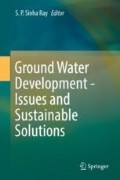Abstract
A group of steel industries situated in the district of Chittagong, Bangladesh, has engaged NRIEMT of Kolkata, India, to study the entire area in and around of their proposed plant areas stretching from Chittagong town in the south to Mirsarai (latitude 22°45′01″ N and longitude 91°35′15″ E) in the north up to the Feni River, Chittagong, Bangladesh, with a length of 70 km (approx) and width varying from 3 to 12 km. This study is essential for obtaining a clear picture of the prospects of groundwater and surface water, and this paper deals with various problems of groundwater.
The present study has thrown light considerably to the fresh groundwater regime which occupies underneath Karnaphuli–Feni interfluve. Being an extension of Sitapahar, the eastern part of the area is characterized by somewhat rugged and irregular topography.
The study area comprises a continuous succession of sandstone and shale. A clear picture about the subsurface deposition of different lithological strata has been revealed from both VES and electrical logging report as well as from a number of drilling of production tube wells at different locations. The entire investigated area has been categorized in 3 (three) segments, namely, north, central and south. The sediments of Tipam group comprise medium- to fine-grained and semi-consolidated sand and form the main aquifer system of the area (equivalent to Tripura of India extension).
The chemical quality of groundwater is overall good, but there is an indication of salinity in the aquifers that exist at a depth of approximately 85.00–125.00 m from north to south. The iron content is also high beyond permissible limit.
This systematic scientific approach has established the existence of a moderate to large potential of groundwater resources in the Karnaphuli–Feni interfluve area. These precious resources will go a long way in supporting industrialization in this otherwise underdeveloped tract of land which will ultimately usher to a new socio-economic horizon in coming years.
Access this chapter
Tax calculation will be finalised at checkout
Purchases are for personal use only
References
Bridge JS (1993) The interaction between channel geometry, water flow, sediment transport and deposition in braided rivers. Geol Soc Lond Spec Publ 1993 75:13–17. https://doi.org/10.1144/GSL.SP.1993.075.01.02
Browder AG, McNinch JE (2006) Linking framework geology and nearshore morphology: correlation of paleo-channels with shore-oblique sandbars and gravel outcrops. Mar Geol 231(2006):141–162
Central Ground Water Board (2006) Dynamic ground water resources of India (As on March, 2004). New Delhi
Central Ground Water Board (2009) Report of the group for suggesting new and alternate
CGWB (2005) Dynamic Ground Water Resources of Kerala, CGWB, Kerala Region unpublished report, p 90
CGWB. 2009. Ground water information booklet, Koch Bihar district, West Bengal. New Delhi: Central Ground Water Board. Retrieved November 15, 2010. http://cgwb.gov.in/istrict Profile/ West Bengal/ Koch_Behar.pdf
CGWB (Centre for Ground Water Board). Report on the Paschim Mednipur District at a Glance, pp 1–21. www.cgwb.gov.in
CGWS (Centre for Ground Water Studies), Kolkata. Geo-hydrogeological study of river “Punarbhaba” and “Atrayee” for creation of sustainable source which includes river morphology study, determination of sub- soil characteristics, metrerological studies, study of surface flow, water quality testing and recommendation division, Dakshin Dinajpur, West Bengal – 2011, 2014
CGWS (Centre for Ground Water Studies), Kolkata. A note on the aquifer performance test of the near surface aquifer in the Siddheswari River bed near Aligarh in Rajnagar block, Birbhum district
Das S (2006) Ground water overexploitation and importance of water management in India – Vision 2025. Tenth IGC foundation lecture. Indian Geological Congress, Roorkee
Dasgupta AB (1986) Quart J Geol Min Met Soc India 58(3):149–170
Geological Map of Bangladesh
GWM and feasibility study, Mirsarai Pourashava- Water Report (Volume 3 of 4). Bangladesh
Institute of Water and Flood Management Bangladesh University of Engineering and Technology, Dhaka-1000. August 2012. Water Availability Analysis for BSRM Steel Mill in Mirsarai Area
Karanth KR (1987) In: Tata McGraw – Hill Publishing Co Ltd (ed) Groundwater development, assessment and management, New Delhi, 610 p
Kranth KR (1987) Groundwater assessment development and management
Methods of Ground Water Resources Assessment. Ministry of Water Resources, Government of India, Faridabad. Cgwb.gov.in/GroundWater/GW_aasessment.htm
Ministry of Water Resources (1997) Report of the Groundwater Resource Estimation Committee. Ground Water Resources Estimation Methodology-1997, 107 p
Shamsudduha M, Chandler RE, Taylor RG, Ahmed KM (2009) Recent trends in groundwater levels in a highly seasonal hydrological system: the Ganges-Brahmaputra-Meghna Delta. Hydrol Earth Syst Sci 13:2373–2385
Survey of India Map, Govt. of India
Todd DK (1959) Ground water hydrogeology. Wiley, Singapore 3999
Acknowledgement
The author expresses his gratitude to the BSRM, Chittagong, Bangladesh, for giving opportunity to publish their paper.
The author is highly grateful to Dr. S.P. Sinha Ray, Former Member, Central Ground Water Board, for giving his valuable inputs, suggestions, guidance and critical evaluation during the preparation of the paper.
The author would like to express sincere thanks to all the executive directors (hydrogeology) and project scientists of NRIEMT engaged in this project.
Author information
Authors and Affiliations
Editor information
Editors and Affiliations
Rights and permissions
Copyright information
© 2019 Springer Nature Singapore Pte Ltd.
About this chapter
Cite this chapter
Saha, R. (2019). Findings of Large Groundwater Development Potential in Deeper Aquifers in Karnaphuli–Feni Interfluve, Chittagong, Bangladesh: A New Scientific Initiative. In: Ray, S. (eds) Ground Water Development - Issues and Sustainable Solutions. Springer, Singapore. https://doi.org/10.1007/978-981-13-1771-2_7
Download citation
DOI: https://doi.org/10.1007/978-981-13-1771-2_7
Published:
Publisher Name: Springer, Singapore
Print ISBN: 978-981-13-1770-5
Online ISBN: 978-981-13-1771-2
eBook Packages: Earth and Environmental ScienceEarth and Environmental Science (R0)

